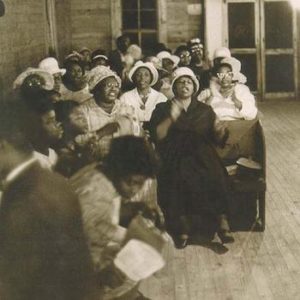
On this date, we briefly focus on Black Spiritual music in America.
Many Black spirituals in America resulted from the white folk music tradition; many others have melody analogs in white-American and British folk music. Borrowing melodies with pentatonic (five-note) and significant scales are exceptionally well known. The voice quality, vocal effects, and the type of rhythm accompaniment that Black spirituals use are where the difference begins and ends. Black spirituals were sung not only in worship but also as work songs, and the lyrics often reflect physical hard work and spiritual inspiration.
Musically, the complex combination of African diaspora folk and African music elements reinforced each other. The call-and-response pattern occurs in both, as do specific scales and the uneven inflections of certain notes. Apparent African influence can be heard in the vocal style, and the complex polyrhythmic clapped accompaniments. African tradition also included polyphonic and choral singing. The Yoruba-based Ring Shout (a religious dance usually accompanied by the singing of spirituals and clapped rhythms) comes from African ancestry. The lyrics of Negro spirituals are tightly linked with the lives of their authors, Slaves.
While work songs dealt only with their daily life, spirituals were inspired by the message of Jesus Christ and his Good News (Gospel) of the Bible, "You can be saved." They differ from hymns and psalms because they share the challenging condition of being a slave. Many slaves in towns and plantations tried to run to a "free country" that they called "my home" or "Sweet Canaan, the Promised Land."
This country was on the Northern side of the Ohio River, which they called "Jordan." Some Negro spirituals refer to the Underground Railroad, an organization that helped slaves run away. After the American Civil War, Black spirituals were "discovered" by Northerners, and harmonized versions were developed. Often sung by trained choirs, the older traditional style was preserved, especially in rural areas and certain sects. Like the white Gospel song, some modern Black gospel songs are a descendant of the spiritual and are accompanied by musical instruments.
Black gospel music is interrelated to secular Black music (as spirituals are to the work songs and blues) and often includes jazz rhythms, instruments, and dance alongside a traditional clapped accompaniment.
In the 1920s, during the Harlem Renaissance, "It was evidenced of a renewed race-spirit that consciously and proudly sets itself apart," explained Alan Locke. The use of dialect was taboo at the beginning of this movement. The "race spirit" infused the work of musicians and writers like Langston Hughes. For the first time, Blacks realized that their roots were deep in the land of their birth. The early 20th century took hold and influenced the way of singing and interpreting Negro spirituals. First, the historical meaning of these songs was put forward.
Then, singers were pushed to be more educated. For example, in the early 20th century, young boys sang Negro spirituals in schoolyards. Their way of singing was not sophisticated, but elders and educators thought that Negro spirituals were musical pieces that must be interpreted. New groups at the time were formed, such as the Highway QC's (QC: Quincy College), and they sang harmonized Negro spirituals. This constant improvement (so to speak) of Negro spirituals gave birth to another type of Christian song, inspired by the Bible (mainly the Gospel) and related to daily life.
Thomas A. Dorsey was the first person to compose such new songs. He called them Gospel songs, but some say "Dorsey's songs." He is considered the Father of Gospel music. During this period, Blacks began to leave the South during the "Great Migration," and Gospel songs became increasingly popular in northern cities like Chicago.
Between 1915 and 1925, many Black singers, like Paul Robeson, performed at church, on stage, or in movies. Negro spirituals were considered mainly traditional songs. In the late 1930s, Sister Rosetta Tharpe dared sing Gospel songs in a nightclub. This was the very beginning of singing Gospel songs in varied venues: churches, theaters, and concert halls, and the number of groups grew at that time.
At the same time, some preachers and their congregations were celebrated; many recorded Negro spirituals and Gospel songs. Ministers like James Cleveland made tours with their choruses in the United States and abroad. In the late 1950s and early 1960s, before and during rallies for American Civil Rights, demonstrators sang Negro spirituals as natural support and kinship. For example, "We Shall Overcome" and "This Little Light of Mine" were popular. Gospel songs are usually composed, but the melodies are taken from improvisational bases in church services. Similarly, popular songs are improvised in the tradition of jazz.
Since the first Martin Luther King Day in 1986, Negro spirituals have been considered pieces of American heritage. They are often in programs and events that remind people of all of Black History. Today, everyone in the United States performs Gospel music. The main issue is improving the African American integrity in singing Negro spirituals and other Christian songs.
An Encyclopedia of African American Christian Heritage
By Marvin Andrew McMickle
Judson Press, Copyright 2002
ISBN 0-817014-02-0